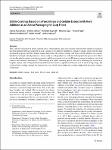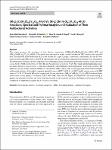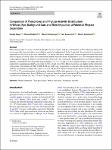Search
Author
- Carlos, Alegría (2)
- Carlos, Seara (2)
- David, Orden (2)
- Klaus, Bretterbauer (2)
- next >
Subject
Date issued
Has File(s)
- true (287)
Search Results
This is the first such study in which a gelatin extract obtained from carp skins enriched with dry herbs (thyme or rosemary) has been prepared. Extracts prepared in such a manner were added to furcellaran coatings. Coatings were tested for their mechanical properties and the obtained results showed that the control coatings, and those with the addition of rosemary, had the best strength-related parameters. A new ready-to-cook product was evaluated with regard to the preservative effects of carp skin gelatin coatings containing rosemary and thyme extracts in terms of pH, biogenic amine formulation, microbial changes and sensorial characteristics. |
Marination is commonly used to preserve fish, which, in combination with other non-thermal technologies, such as vacuum impregnation and high hydrostatic pressure, may help to preserve freshness and extend shelf life. In addition, marination may mask changes in physicochemical properties and the sensory attributes of fish resulting from intense pressurization treatments. In this study, we evaluated the effects of vacuum impregnation (50 mbar for 5 min) alone or in combination with a moderate pressurization treatment (250 MPa for 6 min) on the physicochemical properties, microbiological and oxidative stability, and sensory properties of refrigerated seabream fillets. Compared to conventional marination, vacuum impregnation alone had no effect on the aforementioned properties, except ... |
This paper presents the synthesis of two cluster compounds {(NH4)2[Co(H2O)6]2V10O28·4H2O (C1) and (NH4)2[Ni(H2O)6]2V10O28·4H2O (C2)} which were obtained as single crystals suitable for XRD analysis that revealed their crystallization in the monoclinic (C2/c) and triclinic (P-1) space groups, respectively. Additionally, C1 and C2 were characterized using CHN analysis and FT-IR spectroscopy and their thermal decomposition mechanisms were investigated. The antibacterial activities of both compounds were determined against three human pathogenic bacterial strains {Bacillus cereus ATCC 33,018, Escherichia coli O157:H7 and Pseudomonas aeruginosa ATCC 9027} and one phytopathogenic bacterial strain {Ralstonia solanacearum}, while drug standards {chloramphenicol and streptomycin} were used a... |
When facing today’s scarcity of mineral phosphorus (P) resources and the environmental issues following enhanced P losses especially from agriculture, new solutions need to be implemented. In this framework, the potential for a mechanical separation of a P rich grain fraction from wheat, rye, barley and oats is investigated in order to provide animal feed with reduced organic P content. Thus, P accumulation in manure and soils should be prevented. Also, the subsequent utilization of the separated organic P, which occurs in the form of inositol P, for a sustainable P management via activation of intrinsic enzymes is evaluated. It was shown that in grain layers at 7.0, 5.5, 6.4 and 2.5% cross section of wheat, rye, barley and oats, respectively, maximum inositol P occurs with 1.6, 0.8... |
The present study is directed to find the optimal conditions required for efficient separation and purification of Ce3+ as an analog for lanthanides from Fe3+, Th4+, and Zr4+ (interfering ions) using Amberlite IR120H (AIR120H) resin as a strongly cationic exchange adsorbent. The main factors affecting the separation processes had been investigated and optimized. Ce3+ (Ln3+) as an admixture with Fe3+, Th4+, and Zr4+ was successfully separated by batch and column techniques. The sorption efficiency (S, %) from different acidic media was in this order: HCl > HNO3 > H2SO4. In a quaternary mixture with Fe3+ and Th4+, the maximum separation factor between Ce3+ and Zr4+ was ~ 13 after 90 min of equilibration, and the sorption capacity of AIR120H resin for Ce3+ was 8.2 mg/g. The rate of ads... |
In the bipolar-type alkaline water electrolysis powered by renewable energy, electrocatalysts are degraded by repeated potential change associated with the generation of reverse current. If an electrode has large discharge capacity, the opposite electrode on the same bipolar plate is degraded by the reverse current. In this study, discharge capacity of various transition metal-based electrocatalysts was investigated to clarify the determining factors of electrocatalysts on the reverse current and durability. The discharge capacities from 1.5 to 0.5 V vs. RHE (Qdc,0.5) of electrocatalysts are proportional to the surface area in most cases. The proportionality coefficient, corresponding to the specific capacity, is 1.0 C·m–2 for Co3O4 and 2.3 C·m–2 for manganese-based electrocatalysts... |
Protein-based biomaterials are excellent candidates for biomedical applications since they have similar properties to the extracellular matrix. Recently, the use of sericin (SS), a protein present in the silk cocoon, can be used as biomaterial. To improve their properties, SS biomaterials must be subject to treatments after their manufacturing. Ethanol post-treatments by immersion and solvent vapor, are used for increasing their crystallinity, mechanical and water stability. In this work, the effect of ethanol post-treatment on the properties of SS scaffolds elaborated by the lyophilization technique was evaluated. Four post-treatments were carried out on the samples: immersed in absolute ethanol for 5 min (SS/EtOH 5 min) and for 1 h (SS/EtOH 1 h); and exposition in a saturated etha... |
The physicochemical changes induced by seven different dietary fibers (oat, bamboo, pea, inulin, apple, potato, and wheat) during storage and their effects on the survival of homofermentative Lacticaseibacillus casei subsp. casei (L. casei) in fermented milk matrix were analyzed. For this, an experimental study of the effect of storage time on the microorganisms count and physicochemical properties (pH, titratable acidity, syneresis and viscosity) of milk fermented with L. casei was carried out every two weeks during a storage period of 42 days. Throughout the period studied at 4 °C, no significant differences were found in terms of viscosity values, syneresis rates and L. casei counts, despite the substantial decrease in the pH values. Notably, the substantial increase in the conce... |
Presently, society needs an eco-friendlier alternative for non-biodegradable polymers, nonetheless, synthetic polymers have established the market because of cost and easy to manufacture. To address the challenge of reducing the lifetime of degradation of these polymers, the scope of blending natural biopolymers is effective. This paper focuses on confirming the effectiveness of biodegradation in the molecular level of polymer blends between synthetic polymers and biopolymers. The synthetic polymers such as poly (methyl methacrylate) (PMMA) and poly (vinyl chloride) (PVC) were blended with varying compositions of biodegradable cellulose acetate butyrate (CAB). |
In this study, bionanocomposite films based on poly(lactide) (PLA) plasticised with poly(ethylene glycol) (PEG) (7.5 wt%) and reinforced with various contents of nanofibrillated cellulose (NFC) (1, 3, 5 wt%) were prepared. The hydrothermal degradation was investigated through immersion in several aqueous environments at temperatures of 8, 23, 58, and 70 °C as a function of time (7, 15, 30, 60, 90 days). The effect of water immersion on the physicochemical properties of the materials was assessed by monitoring the changes in the morphology, thermo-oxidative stability, thermal properties, and molar mass through field emission scanning electron microscopy (FE-SEM), thermogravimetric analysis (TGA), differential scanning calorimetry (DSC), and gel permeation chromatography (GPC). |










